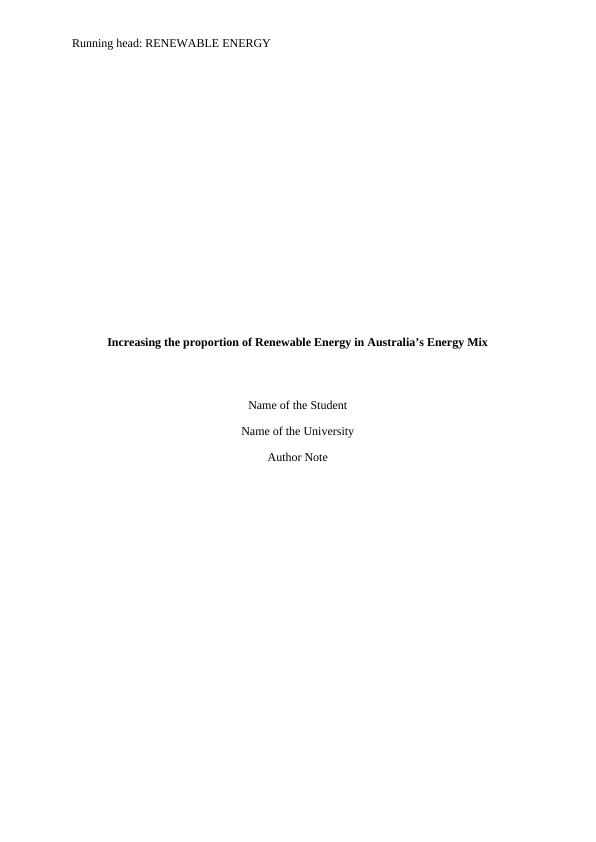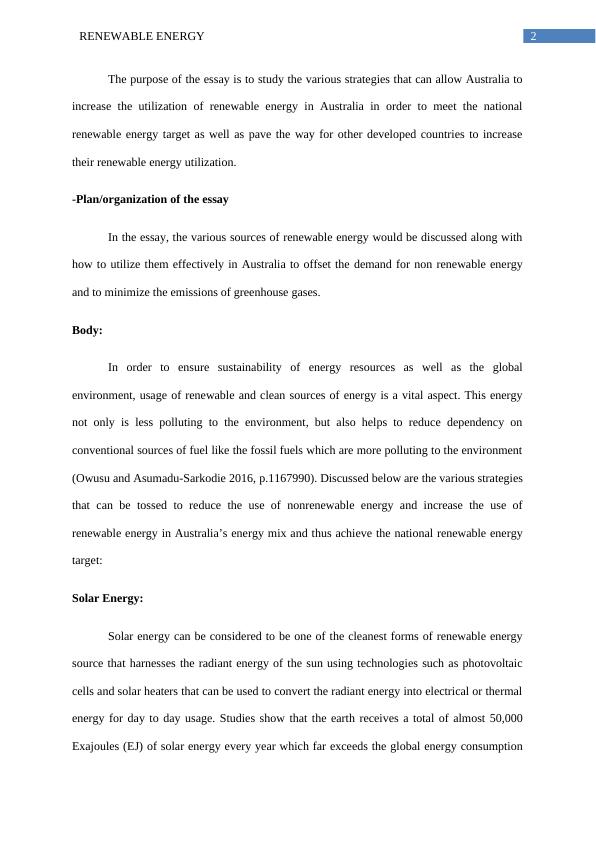Increasing the proportion of Renewable Energy in Australia’s Energy Mix
Added on 2023-05-28
13 Pages3846 Words467 Views
Running head: RENEWABLE ENERGY
Increasing the proportion of Renewable Energy in Australia’s Energy Mix
Name of the Student
Name of the University
Author Note
Increasing the proportion of Renewable Energy in Australia’s Energy Mix
Name of the Student
Name of the University
Author Note

1RENEWABLE ENERGY
Introduction:
-Background to the topic and its significance
Renewable energy is an umbrella term that refers to different types of energy that is
collected from renewable sources that can be replenished naturally. This type of energy can
include solar energy, wind energy, tidal energy, hydroelectric energy, geothermal energy and
bio-energy (Weitemeyer et al. 2015, pp.14-20). Renewable energy is important for the
sustainability of the environment since it allows extraction of energy from renewable
resources and therefore prevents the exploitation and depletion of the non-renewable energy
sources (such as fossil fuels) and helps to reduce pollutions caused by the usage of
nonrenewable energy (Owusu and Asumadu-Sarkodie 2016, p.1167990). Due to this,
developed countries around the world have set up targets for renewable energy use in order to
mitigate the impact of the global greenhouse gas emissions. The Australian government
targets to produce 23.5% of its electricity from renewable resources by 2020 by increasing
the use of solar, wind, tidal and hydroelectric power (Hua et al. 2016, pp.1044-1051).
-The ‘wicked problem’
Usage of non renewable energy have resulted in massive production of greenhouse
gases such as Carbon Dioxide which have caused significant impact on the global climate,
causing an increase in the average global temperature, gradual melting of the polar ice caps,
rise in sea levels and increase in the incidence of erratic weather patterns and climatic
catastrophes (Schlesinger 2017, pp.800-817).
-Relevant terms and concepts
Global warming, renewable energy, non renewable energy
-Aim/purpose of the essay
Introduction:
-Background to the topic and its significance
Renewable energy is an umbrella term that refers to different types of energy that is
collected from renewable sources that can be replenished naturally. This type of energy can
include solar energy, wind energy, tidal energy, hydroelectric energy, geothermal energy and
bio-energy (Weitemeyer et al. 2015, pp.14-20). Renewable energy is important for the
sustainability of the environment since it allows extraction of energy from renewable
resources and therefore prevents the exploitation and depletion of the non-renewable energy
sources (such as fossil fuels) and helps to reduce pollutions caused by the usage of
nonrenewable energy (Owusu and Asumadu-Sarkodie 2016, p.1167990). Due to this,
developed countries around the world have set up targets for renewable energy use in order to
mitigate the impact of the global greenhouse gas emissions. The Australian government
targets to produce 23.5% of its electricity from renewable resources by 2020 by increasing
the use of solar, wind, tidal and hydroelectric power (Hua et al. 2016, pp.1044-1051).
-The ‘wicked problem’
Usage of non renewable energy have resulted in massive production of greenhouse
gases such as Carbon Dioxide which have caused significant impact on the global climate,
causing an increase in the average global temperature, gradual melting of the polar ice caps,
rise in sea levels and increase in the incidence of erratic weather patterns and climatic
catastrophes (Schlesinger 2017, pp.800-817).
-Relevant terms and concepts
Global warming, renewable energy, non renewable energy
-Aim/purpose of the essay

2RENEWABLE ENERGY
The purpose of the essay is to study the various strategies that can allow Australia to
increase the utilization of renewable energy in Australia in order to meet the national
renewable energy target as well as pave the way for other developed countries to increase
their renewable energy utilization.
-Plan/organization of the essay
In the essay, the various sources of renewable energy would be discussed along with
how to utilize them effectively in Australia to offset the demand for non renewable energy
and to minimize the emissions of greenhouse gases.
Body:
In order to ensure sustainability of energy resources as well as the global
environment, usage of renewable and clean sources of energy is a vital aspect. This energy
not only is less polluting to the environment, but also helps to reduce dependency on
conventional sources of fuel like the fossil fuels which are more polluting to the environment
(Owusu and Asumadu-Sarkodie 2016, p.1167990). Discussed below are the various strategies
that can be tossed to reduce the use of nonrenewable energy and increase the use of
renewable energy in Australia’s energy mix and thus achieve the national renewable energy
target:
Solar Energy:
Solar energy can be considered to be one of the cleanest forms of renewable energy
source that harnesses the radiant energy of the sun using technologies such as photovoltaic
cells and solar heaters that can be used to convert the radiant energy into electrical or thermal
energy for day to day usage. Studies show that the earth receives a total of almost 50,000
Exajoules (EJ) of solar energy every year which far exceeds the global energy consumption
The purpose of the essay is to study the various strategies that can allow Australia to
increase the utilization of renewable energy in Australia in order to meet the national
renewable energy target as well as pave the way for other developed countries to increase
their renewable energy utilization.
-Plan/organization of the essay
In the essay, the various sources of renewable energy would be discussed along with
how to utilize them effectively in Australia to offset the demand for non renewable energy
and to minimize the emissions of greenhouse gases.
Body:
In order to ensure sustainability of energy resources as well as the global
environment, usage of renewable and clean sources of energy is a vital aspect. This energy
not only is less polluting to the environment, but also helps to reduce dependency on
conventional sources of fuel like the fossil fuels which are more polluting to the environment
(Owusu and Asumadu-Sarkodie 2016, p.1167990). Discussed below are the various strategies
that can be tossed to reduce the use of nonrenewable energy and increase the use of
renewable energy in Australia’s energy mix and thus achieve the national renewable energy
target:
Solar Energy:
Solar energy can be considered to be one of the cleanest forms of renewable energy
source that harnesses the radiant energy of the sun using technologies such as photovoltaic
cells and solar heaters that can be used to convert the radiant energy into electrical or thermal
energy for day to day usage. Studies show that the earth receives a total of almost 50,000
Exajoules (EJ) of solar energy every year which far exceeds the global energy consumption

3RENEWABLE ENERGY
(Lewis 2016, pp.403-415). This abundant source of energy can therefore be a perfect solution
to meet rapidly growing energy needs and reducing the dependency on nonrenewable energy.
Usage of solar panels and solar farms can help to generate large amount (about trillions of
watts of energy, enough to power thousands of households and even factories (Tsalikis and
Martinopoulos 2015, pp.743-756). Moreover, technologies such as solar powered hydrogen
fuel cells can also increase the efficiency of solar power usage and its storage thereby helping
to significantly offset the usage of fossil fuels (O'hayre et al. 2016).
Wind Energy:
This is another clean source of renewable energy which is not associated with
greenhouse emissions. Wind energy can be harnessed through wind turbines that can convert
the kinetic energy of wind to mechanical energy and generators can then convert the
mechanical energy to electrical energy (Yaramasu et al. 2015, pp.740-788). Currently about
5.9% of Australia’s electrical energy is produced from wind energy creating more than 48000
megawatts of electricity every year (Katsigiannis and Stavrakakis 2014, pp.230-236). Thus,
developing more wind farms across Australia can help to harness more wind energy,
especially around the coastal regions and thus help to increase the use of renewable energy in
the energy mix of the country.
Tidal Energy:
Tidal energy utilizes the force of the oceanic tides and tidal waves to harness energy
or electricity. The movement of tidal water is used to rotate turbines installed in the inter tidal
zones thereby converting the kinetic energy of the water to mechanical energy and then
convert the mechanical energy to electrical energy using motors (Lewis et al. 2015, pp.403-
415). The extensive coastline of Australia provides a unique opportunity for harnessing its
power as an alternate as well as inexhaustible energy source for the entire country (Penesis et
(Lewis 2016, pp.403-415). This abundant source of energy can therefore be a perfect solution
to meet rapidly growing energy needs and reducing the dependency on nonrenewable energy.
Usage of solar panels and solar farms can help to generate large amount (about trillions of
watts of energy, enough to power thousands of households and even factories (Tsalikis and
Martinopoulos 2015, pp.743-756). Moreover, technologies such as solar powered hydrogen
fuel cells can also increase the efficiency of solar power usage and its storage thereby helping
to significantly offset the usage of fossil fuels (O'hayre et al. 2016).
Wind Energy:
This is another clean source of renewable energy which is not associated with
greenhouse emissions. Wind energy can be harnessed through wind turbines that can convert
the kinetic energy of wind to mechanical energy and generators can then convert the
mechanical energy to electrical energy (Yaramasu et al. 2015, pp.740-788). Currently about
5.9% of Australia’s electrical energy is produced from wind energy creating more than 48000
megawatts of electricity every year (Katsigiannis and Stavrakakis 2014, pp.230-236). Thus,
developing more wind farms across Australia can help to harness more wind energy,
especially around the coastal regions and thus help to increase the use of renewable energy in
the energy mix of the country.
Tidal Energy:
Tidal energy utilizes the force of the oceanic tides and tidal waves to harness energy
or electricity. The movement of tidal water is used to rotate turbines installed in the inter tidal
zones thereby converting the kinetic energy of the water to mechanical energy and then
convert the mechanical energy to electrical energy using motors (Lewis et al. 2015, pp.403-
415). The extensive coastline of Australia provides a unique opportunity for harnessing its
power as an alternate as well as inexhaustible energy source for the entire country (Penesis et

End of preview
Want to access all the pages? Upload your documents or become a member.
Related Documents
Fossil Fuel Energy to Renewable Energylg...
|10
|2456
|400
Non-Fossil Fuel Transportationlg...
|9
|2576
|310
Clean Technologies and Environmental Policylg...
|9
|1947
|22
Strategies to Mitigate the Impact of Global Climatic Changelg...
|6
|998
|251
Atmosphere pollution Assignment PDFlg...
|7
|1571
|30
Carbon Tax is Best Solution for the Climate Changelg...
|6
|2016
|327